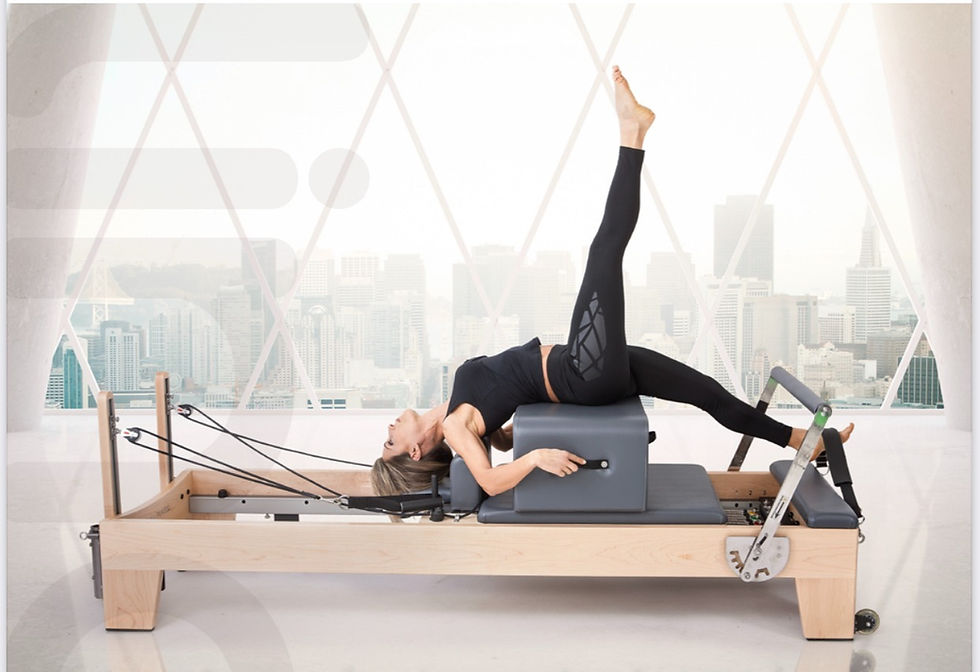Reformer Pilates
- blog - Allia Miloucheva

- Aug 16, 2021
- 3 min read
Updated: Mar 13, 2023
The Pilates Method
The Pilates Method is a physical fitness system developed in the early 20th century by Joseph Pilates. As of 2005 there are 11 million people who practice the discipline regularly just in USA. Pilates called his method Contrology, because he believed his method uses the mind to control the muscles. The program focuses on the core postural muscles which help keep the body balanced and which are essential to providing support for the spine. In particular, Pilates exercises teach awareness of breath and alignment of the spine, and aim to strengthen the deep torso muscles.

History
Pilates was formed by Joseph Pilates during the First World War with the proposal to improve the rehabilitation program for the many returning veterans. Joseph Pilates believed mental and physical health are essential to one another. He recommended a few, precise movements emphasizing control and form to aid injured soldiers in regaining their health by strengthening, stretching, and stabilizing key muscles. Pilates created "The Pilates Principles" to condition the entire body: proper alignment, centring, concentration, control, precision, breathing, and flowing movement. Pilates sessions claim to help increase strength and flexibility, lengthen the body, and align the spine.
Principles
Pilates claimed his method has a philosophical and theoretical foundation. It claims not merely to be a collection of exercises but a method developed and refined over more than eighty years of use and observation. One interpretation of Pilates Principles: Centering, Concentration, Control, Precision, Breathing, and Flowing Movement, is similar to yoga.
Mind over matter
According to practitioners, the central element of Pilates is to create a fusion of mind and body, so that without thinking about it the body will move with economy, grace, and balance; using one's body to the greatest advantage, making the most of its strengths, counteracting its weaknesses, and correcting its imbalances. The goal is to produce an attention-free union of mind and body, the method requires that one constantly pays attention to one's body while doing the movements. Paying attention to movement is so vital that it is more important than any other single aspect of the movements or the method...
Breathing
Joseph Pilates believed in circulating the blood so that it could awaken all the cells in the body and carry away the wastes related to fatigue. For the blood to do its work properly, it has to be charged with oxygen and purged of waste gases through proper breathing. Full and thorough inhalation and exhalation are part of every Pilates exercise. Pilates saw forced exhalation as the key to full inhalation. "Squeeze out the lungs as you would wring a wet towel dry," he is reputed to have said. Breathing too, should be done with concentration , control, and precision. It should be properly coordinated with movement. Each exercise is accompanied by breath in instructions. Joseph Pilates stated, "Even if you follow no other instructions, learn to breathe correctly.
Centering
Pilates called the very large group of muscles in the centre of the body – encompassing the abdomen, lower back, hips, and buttocks – the "powerhouse." All energy for Pilates exercises begins from the powerhouse and flows outward to the extremities. Physical energy exerted from the centre coordinates one's movements. Pilates felt that it was important to build a strong powerhouse in order to rely on it in daily living. Modern instructors call the powerhouse the "core".
Concentration
Pilates demands intense focus. For instance, the inner thighs and pelvic floor may be accessed when doing a standing exercise that tones the triceps. Beginners learn to pay careful attention to their bodies, building on very small, delicate fundamental movements and controlled breathing. In 2006, at the Parkinson Centre of the Oregon Health and Science University in Portland, Oregon, the concentration factor of the Pilates method was being studied in providing relief from the degenerative symptoms of Parkinson's disease.
Control
Joseph Pilates built his method on the idea of muscle control. That meant no sloppy, uncontrolled movements. Every Pilates exercise must be performed with the utmost control, including all body parts, to avoid injury and produce positive results. It's not about intensity or multiple repetitions of a movement, it's more about proper form for safe, effective results.
Precision
Every movement in the Pilates method has a purpose. Every instruction is vitally important to the success of the whole. To leave out any detail is to forsake the intrinsic value of the exercise. The focus is on doing one precise and perfect movement, rather than many half-hearted ones. Eventually this precision becomes second nature, and carries over into everyday life as grace and economy of movement.
ALL I AM Showroom в София е официален представител за Елина Реформър. Уредите са от най-висок клас и са подходящи както за пилатес и фитнес студия, спа центрове, така и за домашна употреба.







Comments